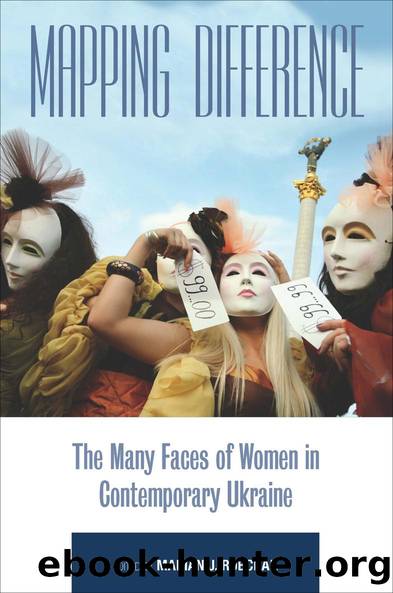Mapping Difference by Marian J. Rubchak

Author:Marian J. Rubchak [Rubchak, Marian J.]
Language: eng
Format: epub
ISBN: 9781782386735
Barnesnoble:
Publisher: Berghahn Books, Incorporated
Published: 2014-08-01T00:00:00+00:00
Notes
1. In the history of Ukraine, womenâs studies became an actual field of research only in the 1990s. For a detailed overview of recent developments of womenâs and gender history in Ukraine, see Oksana Kisâ 2010, and 2004: 291â302.
2. The project was conducted at the Institute of Ethnology, National Academy of Sciences of Ukraine, and was supported by a research grant from the Canadian Institute of Ukrainian Studies, University of Alberta.
3. For more information about this cross-national venture, its goals, methodology, chronology, etc. see http://www.womensmemory.net.
4. Gluck 1977: 3â13; Sangster 1994: 5â28; Gluck and Patai 1991. For a further discussion on gender differences in historical memory see Leydesdorff 1996.
5. Eight interviews in Lâviv, ten in Kharkiv, and ten in Simferopilâ were recorded by the end of 2005.
6. The external questions were: (1) What does the Soviet regime mean in your life? (2) What do you think about people of various ethnicities living next to you? (3) Identify the historical events which have had the most influence on your life. (4) What is the significance of Ukrainian independence in your life? (5) What was most helpful for overcoming hardships in your life?
7. The policy of anonymity precludes the inclusion of intervieweesâ personal data (including names, date and place of birth, current address, etc.). Each interview was assigned a special code: the first letter U means the country, the second (L, K, or S) indicates the city where the interview was recorded, the subsequent digits identify the interviewâs number; the numbers after a dash refer to the year of recording, and the figures after the colon refer to the number of lines excerpted from the transcript.
8. In 1932â33 between 4.5 and 8.1 million Ukrainians died as a result of the famine engineered by Stalin; the year 1937 is known for mass political repressions throughout the USSR.
9. For a detailed analysis of this issue, see: Kisâ 2009: 337â52.
10. Komsomolâabbreviation for Komunisticheskyi Soiuz Molodezhi (Communist Union of Youth), the youth subdivision of the Communist Party of the Soviet Union.
11. Banderivka, banderivtsi are followers of Stephan Bandera (1909â1959), leader of the Organization of Ukrainian Nationalists, and a key figure in Ukraineâs national liberation movement of 1930â1950. He was murdered by a KGB agent in Munich. Zapadenka, zapadentsi are people from western Ukraine. These designations are associated with the nationalist struggle against the Soviet regime, together with its Russification policy, and generally carry negative connotations. Also known as Petliurivtsiâfollowers of Semen Petliura (1877â1926)âUkrainian politician, statesman, and one of the commanders in the âDirectory of the Ukrainian Peopleâs Republic,â which opposed the Bolshevik regime between 1918 and 1920.
12. Kahneman and Tversky 1981: 4553â58; Hutton 2001.
13. It was during âKhrushchevâs thawâ and Shelestsâs Ukrainianization agenda in the late 1960s.
Download
This site does not store any files on its server. We only index and link to content provided by other sites. Please contact the content providers to delete copyright contents if any and email us, we'll remove relevant links or contents immediately.
Spell It Out by David Crystal(35852)
Underground: A Human History of the Worlds Beneath Our Feet by Will Hunt(11843)
A Year in the Merde by Stephen Clarke(5080)
Venice by Jan Morris(2436)
Claridge's: The Cookbook by Nail Martyn & Erickson Meredith(2259)
My Paris Kitchen: Recipes and Stories by Lebovitz David(2135)
A TIME OF GIFTS by Patrick Leigh Fermor(2103)
The Plantagenets by Dan Jones(1935)
Welcome to the Goddamn Ice Cube by Blair Braverman(1888)
Bang Poland: How To Make Love With Polish Girls In Poland by Roosh V(1862)
Top 10 Prague (EYEWITNESS TOP 10 TRAVEL GUIDES) by DK(1852)
The Finnish Way by Katja Pantzar(1811)
The Isle of Mull by Terry Marsh(1806)
From Russia with Lunch by David Smiedt(1798)
A TIME TO KEEP SILENCE by Patrick Leigh Fermor(1774)
Rick Steves London 2018 by Rick Steves & Gene Openshaw(1752)
A Taste of Paris by David Downie(1747)
Merde in Europe by Stephen Clarke(1672)
Insight Guides Experience Tokyo by Insight Guides(1660)
